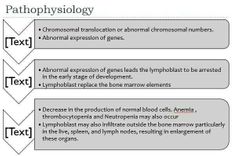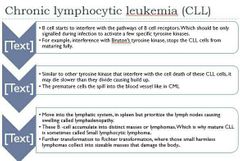![]()
![]()
![]()
Use LEFT and RIGHT arrow keys to navigate between flashcards;
Use UP and DOWN arrow keys to flip the card;
H to show hint;
A reads text to speech;
50 Cards in this Set
- Front
- Back
- 3rd side (hint)
|
Malignant neoplasms of the hematopoietic stem cells with diffuse replacement of bone marrow. |
Leukemia |
|
|
|
4 main types of leukemia |
✔Acute lymphoblastic(lymphocytic)leukemia (ALL) ✔Acute myeloid(myelogenous) leukemia (AML) ✔Chronic lymphocytic leukemia (CLL) ✔Chronic myeloid (myelogenous) leukemia(CML) |
|
|
|
This involves immature lymphocytes and their progenitors that originate in the bone marrow but infiltrate the spleen, lymphnodes, CNS and other tissues. |
Lymphocytic leukemia |
|
|
|
This involves the pluripotent myeloid stem cells in bone marrow and interfere with the maturation of all blood cells, including the granulocytes, erythrocyters and thrombocytes. |
Myelogenous leukemia |
|
|
|
This tyoe has greater that 20%blast cell in the bone marrow, and blast cell “crowds out” that leads to inhibition of production of other blood cell. |
Acute leukemia |
|
|
|
This type of acute leukemia is the build up of lymphoid blast cells. |
Acute lymphoblastic (lymphocytic) leukemia (ALL) |
|
|
|
This type of acute leukemia is the build up of myeloid blast cells. |
Acute myeloid (myelogenous) leukemia (AML) |
|
|
|
A condition ij which there is an abnormal build up of blast which is below 20 %. Also, means "bad formation of bone marrow" |
Myelodysplastic syndrome |
|
|
|
It is a DNA polymerase that is present only in the nucleus of lymphoblast, not in the lymphoblast or more mature cells or more mature cells and not in myeloblast |
TDT- Terminal deoxynucleotidyl transferase |
|
|
|
TRUE OR FALSE. Lymphoblast has positive nuclear staining or TdT’s in the cell nucleus |
True |
|
|
|
Enzyme in myeloblasts |
Myeloperoxidase |
|
|
|
A crystalized version of myeloperoxidase that can be seen in cytoplasmic staining. |
Auer rods |
|
|
|
It is a malignant disease of the bone marrow in which early lymphoid precursors proliferate and replace the normal hematopoetic cell of the marrow. |
Acute lymphoblastic leukemia |
|
|
|
Most common type of cancer of leukemia in children. |
Acute lymphoblastic leukemia |
|
|
|
It is resistant to therapy, heamatopoietic stem cell |
Preleukemic clone |
|
|
|
Etiology of acute lymphoblastic leukemia |
It is concluded that the B-cell precursor ALL has a multifactorial etiology, with 2 step process of genetic mutation and exposure to infection playing a prominent role 1.) first step occurs in utero, when fusion gene formation or hyperdiploidy generates a covert, preleukemic clone 2.) second step is the post natal acquisition of secondary genetic changes that drive the conversion to overt leukemia. |
|
|
|
Subtypes of acute lymphoblastic leukemia |
B Acute lymphoblastic leukemia T Acute lymphoblastic leukemia |
|
|
|
It is commonly seen and has specific markers C10, C19 and C20 |
B Acute lymphoblastic leukemia |
|
|
|
Tx for B Acute lymphoblastic leukemia |
Chemotherapy |
|
|
|
Etiology of subtype B ALL |
Translocation of chromosome 12 and 21 t(12;21) happens on children |
|
|
|
A t( 9;22) or sometimes called __________ seen more in adults. |
Philadelphia chromosome |
|
|
|
A subtype of ALL in which its surface markers range from CD2 to CD8. It has present thymic mass in the mediastinum that happens on teenagers |
T Acute lymphoblastic leukemia |
|
|
|
It is called acute lymphoblastic lymphoma |
T Acute lymphoblastic leukemia |
|
|
|
Leukemia vs. Lymphoma |
In leukemia, malignant cell float around in the blood, in lymphoma malignant cell forms into mass. |
|
|
|
Pathophysiolgy of ALL |

|
|
|
|
Risk factors of ALL |
✔Male✔Being white✔Previous chemotherapy treatment✔Exposure to radiation |
|
|
|
Symptoms of acute lymphoblastic leukemia |
✔Weakness or feeling tired✔Fever✔Easy bruising or bleeding✔Bleeding under the skin✔Shortness of breath✔Weight loss or loss of appetite✔Pain the bones or stomach✔Pain or Feeling of fullness below the ribs✔Painless lumps in the neck, underarm, stomach or groin |
|
|
|
Tx for acute lymphoblastic leukemia |
✅Chemotherapy✅Radiation therapy✅Stem cell transplants✅Targeted therapy – does not harm normal effect |
|
|
|
It is a malignant disease of the bone marrow in which hematopoietic precursors are arrested in an early stage of development. |
Acute myeloid (myelogenous) leukemia (AML) |
|
|
|
Other terms for Acute myeloid leukemia |
acute myelocytic leukemia, acute granulocytic leukemia, acute non-lymphocytic leukemia. |
|
|
|
Most common acute leukemia in adults. (50-60yrs. old) |
Acute myeloid (myelogenous) leukemia (AML) |
This type of cancer usually gets worse quickly if not treated. |
|
|
Etiology of AML |
Antecedent hematologic disorders Familial syndromes Environmental exposures Drug exposure |
Germline mutation gene AML1 (RUNX1, CBFA2) moderate cytopenia, autosomal dominant disorder |
|
|
Subclassification of AML |
Cytogenetic abnormalities Lineage of myeloblast Surface markers |
|
|
|
Important subtype of cytogenic abnormality |
Acute promyelocytic leukemia |
|
|
|
It is characterized by translocation of chromosomes 15 and 17 or t(15;17) |
Acute promyelocytic leukemia |
|
|
|
TRUE OR FALSE. The translocation of chromosomes 15 and 17 ends up disrupting the retinoic acid receptor which alters the ability of the cell to mature leading to build up of promyelocytes. |
True |
|
|
|
Lineage of myeloblast |
⚪Erythroblast AML ⚪Megakaryoblast AML -build up of megakaryoblast-No myeloperoxidase -There’s an association with down syndrome before the age of five ⚪Monoblast AML – or the Acute Monocytic Leukemia -Monoblast build up and these lack myeloperoxidase -it is now observed infiltration of patients gums. -Classic sign. |
|
|
|
It is a derivative of vitamin A that binds to the disrupted retinoic acid receptor and causes the blast to mature into neutrophils which eventually go on to die but it does lessen the leukemic burden since there isn’t as many blasts floating around. |
All-trans-retinoic acid (ATRA) |
|
|
|
A cancer of the leukocytes, wherein there is a lot of partially developed white blood cell in the blood for a very long period of time. |
Chronic leukemia |
|
|
|
Characteristic of chronic leukemia |
Normal cells are being “crowded out” |
|
|
|
Most common cause of chronic leukemia |
chromosomal abnormalities in hematopoietic stem cell that are destined to become leukocytes. Eg. Chromosomal deletion, trisomy, translocation. |
|
|
|
A type of chronic leukemia in which the cells divide too quickly, and usually happens on middle aged or older. |
Chronic myeloid (myelogenous) leukemia (CML) |
The only known risk is exposure to high levels or radiation. |
|
|
Phases of chronic myeloid leukemia |
✔Chronic phase – earliest stage, easiest to treat, has no symptoms ✔Accelerated phase – Increase in abnormal blood cells. - Symptoms: feeling tired, fever, bruises, night sweats, short of breath, lose of some weight, loss of appetite, pain or swelling on the left side of abdomen (enlargement of spleen), pain of bones. ✔Blastic phase – leukemia cell multiply . - Symptoms: infection, bleeding, skin changes including bumps and tumors, swollen glands, bone pain. |
|
|
|
Treatment for chronic myeloid leukemia |
Tyrosine kinase inhibitors – slows down the rate by which the body makes leukemia |
|
|
|
Pathophysiology of chronic myeloid leukemia |

|
|
|
|
It is a cancer that affects the lymphocyte in which the cells don’t die as they should |
Chronic lymphocytic leukemia (CLL) |
- Common in adults. - The cause is most likely mutation also however specidic chromosome is unknown |
|
|
Pathophysiology of chronic lymphocytic leukemia |

|
|
|
|
Tx for chronic lymphocytic anemia |
✔For detection: Aspiration and Biopsy is performed: ⚫Aspiration – thin, hollow needle is inserted into the bone ( hip) to take small amount of liquid marrow. ⚫Biopsy – uses slightly larger needle to remove a small amount of bone, marrow, and blood. ✔Chemotherapy ✔Immunotherapy ✔Target therapy ✔Radiation therapy ✔Surgery ✔Leukapheresis ✔Stem cell transplants |
|
|
|
Symptoms of chronic leukemia |
✔In CML, hepatosplenomegaly - Feeling of fullness ✔In CLL, lymphadenopathy - Pain in the lymph node |
|
|
|
Diagnosis for chronic leukemia |
✔Starts with blood smear ⚫In CML – increase granulocytes and monocytes ⚫In CLL – smudge cells- immature b cell that are brocken in the smear. ✔Genetic testing could be done to look for Philadelphia gene |
|

